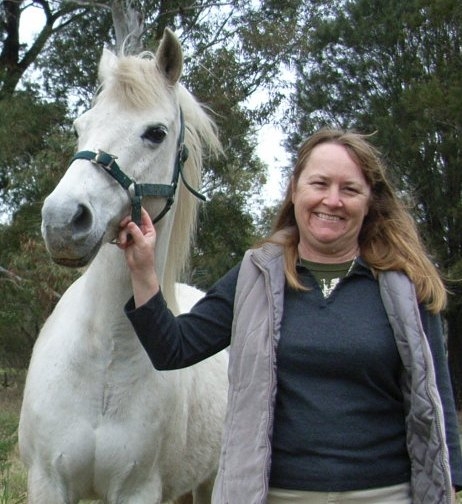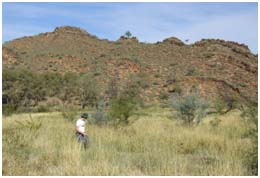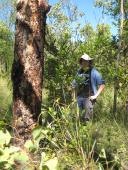diagnostics
The evolution of diagnostics
On Sunday 12 February 1809, Charles Robert Darwin was born; a British naturalist who would become famous for his contribution to science and theories of evolution. During 1829 while studying a Bachelor of Arts, he began eagerly collecting beetles, with some of his findings published in Stephens' Illustrations of British Entomology.
Step forward 200 years and Darwin's legacy into diagnostics continues with the launch of two unique web-based tools which quickly and accurately identify plant pests and diseases threatening Australia.
Deb Hailstones
 My name is Deb and my role at CRC for National Plant Biosecurity is Program Leader for Diagnostics Research. I am employed by the New South Wales Department of Primary Industries and in this role I am the Research Leader, Production Horticulture. This role involves managing 45 staff at eight locations around New South Wales. I am based at the Elizabeth Macarthur Agricultural Institute which is on the outskirts of Sydney.
My name is Deb and my role at CRC for National Plant Biosecurity is Program Leader for Diagnostics Research. I am employed by the New South Wales Department of Primary Industries and in this role I am the Research Leader, Production Horticulture. This role involves managing 45 staff at eight locations around New South Wales. I am based at the Elizabeth Macarthur Agricultural Institute which is on the outskirts of Sydney.
This project evaluated two of the newer discovery platforms, proteomics and metabolomics, for effectiveness in the identification of functional biomarkers that differentiate closely related bacterial pathovars. Diagnostics based on functional molecules linked to pathogenicity overcome the limitations of many diagnostics based on anonymous, plasmid-borne or incidental targets. Selected biomarkers were adapted to reliable, high throughput, rapid turn-around diagnostics for the model organisms.
Research outcomes:
This project has demonstrated the effectiveness of proteomics and metabolomics, two novel approaches that identify functional molecules, to discover biomarkers that differentiate closely related bacteria.
Novel diagnostic targets have been identified and validated that differentiate organisms to the levels of specificity required, but not previously available.
Novel diagnostics will translate to improved incursion response because their greater specificity and reliability reduce turn around time.
New specialist capacity and partnerships developed.
Research implications:
This project has delivered positive results in terms of scientific resources and human capacity. The finding that these platforms can fast-track the identification of biomarkers with new specificities, and at the level required, can inform investment decisions for the PBCRC in future.
New diagnostic technologies have been developed that will be incorporated into the National Diagnostic Protocol (NDP) and could be adapted to delivery through a range of other platforms. This provides security to industry and those responsible for surveillance and disease management programs. Extensive data has been generated that is yet to be mined, but is likely to deliver further tests in future, without significant further investment.
Significant specialist capacity in bacteriology has been fostered both nationally and internationally, through recruitment and professional development, which will benefit Australia’s plant industries through local expertise and trusted ‘off-shore intelligence’.
Acknowledgements:
Gary Kong and the CRC NPB Board for funding a ‘blue sky’ project.
Leanne Bringolf for excellent technical assistance.
Aneesha Deanensen for initial technical work at SABC.
Platforms to differentiate exotic pathovars of plant bacteria - Final Report
PROJECT LEADER

Dr Deborah Hailstones
Project Leader CRC20054: Plant Bacteria Platforms
deborah.hailstones@industry.nsw.gov.au
Phone: 02 4640 6442
Fax: 02 4640 6300
Read More
PROJECT DETAILS
Complete
Term
February 2008 – December 2010
Budget
$688,600 (cash and in-kind support)
PROGRAM DETAILS
LOCATION
The uses of plant disease and insect collections are numerous but most importantly for taxonomic research and comparative biology. From a biosecurity perspective, these collections allow the development of specimen-based pest lists that are critical for resolving quarantine issues related to agricultural trade. Typically, plant disease and insect specimens are stored in a way that helps preserve the organisms' morphology but not necessarily their DNA. In the age of genomics, DNA sequencing has become one of the most important tools for identifying organisms and for biodiversity studies.
Research outcomes:
The major outcome of this project was the development of the Biosecurity Bank, a national reference collection of DNA samples from plant pathogens. In building the framework for the Biosecurity Bank, the existing Queensland Primary Industries and Fisheries Plant Disease Herbarium database was modified to include new fields for the archiving of information relating to DNA samples and clones. Using this database, it is now possible to link DNA samples to voucher specimens to facilitate taxonomic verification at a later date.
A new web site, www.biosecuritybank.com, was also developed to provide a portal to the DNA collection for the general scientific community to allow searches for samples of interest. The domain has been registered and the site is now live and hosted by Southern Cross University.
A method for storing DNA at room temperature was evaluated but unfortunately, this method did not preserve the DNA as well as storage in a freezer and therefore the latter has been adopted for maintenance of the collection.
Work has begun to populate the Biosecurity Bank with samples and so far 36 samples have been added including those from pathogens that cause citrus canker, tomato leaf curl and Panama disease.
Research implications:
Plant disease herbariums are reference collections of microorganisms (plant pathogens) that cause disease on crops, weeds and native plant species. Specimens held in these collections are important for taxonomic and biodiversity research but also are very important for biosecurity as they allow the development of specimen-based pest lists that are needed for resolving quarantine issues associated with agricultural trade.
Pressed plant specimens are the most common type of specimen held in plant disease herbariums, and provide a good record of the pathogen’s morphology. However, as previously stated this method of storage is sub-optimal for preserving DNA.
In developing the Biosecurity Bank, the Australian scientific community is now provided with a reference collection of DNA samples from plant pathogens, which could potentially be used in all types of research projects, from the development of molecular diagnostic assays to ‘gene-mining’ for biologically-active compounds. To provide even greater assurance of the origin of the DNA, samples will be linked to voucher specimens held in Australian plant disease herbariums.
Acknowledgements:
Funding from the Office the Chief Plant Protection Officer, Australian Department of Agriculture, Fisheries and Forestry, is gratefully acknowledged.
PROJECT LEADER
Dr Andrew Geering
Project Leader CRC20055: DNA Databank
andrew.geering@deedi.qld.gov.au
Phone: 07 3896 9353
Fax: 07 3896 9533
Read More
PROJECT DETAILS
Complete
Term
July 2007 - April 2008
Budget
$129,000 (cash and in-kind resources)
PROGRAM DETAILS
LOCATION
CORE CRC PARTICIPANTS
SUPPORTING CRC PARTICIPANTS
PaDIL
 PaDIL is an image based website designed to create a 'virtual reference collection of pests and diseases'. Ken Walker tells us more about PaDIL and how it is used to identify a range of pests and diseases.
PaDIL is an image based website designed to create a 'virtual reference collection of pests and diseases'. Ken Walker tells us more about PaDIL and how it is used to identify a range of pests and diseases.
Through a web-based remote microscope system, this project will improve the responsiveness to potential incursions by reducing delays in diagnosis, particularly in remote areas. This technology will provide national and international real-time microscope links between experts and non-experts. Diagnostic centres will be linked via web-based communication, for example, through an access portal located on the Diagnostic Database website see CRC27012.
What is the biosecurity problem?
Currently, biological specimens requiring identification are mailed to taxonomic experts for determination. This may take several days and delay diagnosis and any response to deal with potential incursions.
The main output of this project is to:
- evaluate the effectiveness and practicalities of using web-based microscopes in the field, linked to plant laboratories supported by user-friendly software, to dramatically reduce the time required for expert taxonomic identification of emergency plant pests.
Who will be the end-users of this research?
The system will be used by biosecurity researchers (expert-to-expert) and operational staff (expert-to-non-expert) who will have the opportunity to access the remote microscope network via central hubs.

PROJECT LEADER
Dr John La Salle
Project Leader CRC20025: Remote Microscopes
john.lasalle@csiro.au
Phone: 02 6246 4262
Fax: 02 6242 4264
Read More
PROJECT DETAILS
Complete
Term
December 2006 – December 2007
Budget
$161,000 (cash and in-kind support)
PROGRAM DETAILS
LOCATION
This project discovered whether Australian smuts represent a monophyletic group and what ecological factors shaped the diversity of smut fungi in Australia. It also researched whether the evolution of host plants drove the evolution of the smut fungi. It also looked at whether there are molecular loci that allow for nano-scale diagnostic techniques to distinguish smut species and if there are any morphological synapomorphies within smut fungi that will allow them to be split into clear taxonomic groups.
What is the biosecurity problem?
The biodiversity of smut fungi is immense. Vast numbers of cryptic and intriguing smuts occur naturally in undisturbed ecosystems. Smuts occupy many ecological niches and a close relative, the dandruff fungus Malasezzia, even infects animals. Grasses including crops such as wheat, sugarcane, rice, maize and sorghum are all susceptible to smut infection. Diseased plants become infertile as their flowers or seeds are substituted with masses of black, powdery spores. For some cereal grains, entire harvests can become near worthless with the presence of smut spores. It has been estimated that the introduction of wheat smut (Karnal bunt caused by Tilletia indica) to Australia would cause a $A.1.3 billion sway in the economy through a loss of wheat exports, new import costs and job redundancies.
Over 1,500 smut species are known and we are on the verge of understanding the evolution and resolving the taxonomic issues within the group. Australian smut fungi have been comprehensively qualified and their identification has been revolutionized by an interactive, computerized key (Lucid). However, there is some turmoil within the classification of smut fungi as some genera/groups (in particular the Ustilago/Sporisorium/Macalpinomyces complex) overlap causing confusion with species placement. This is problematic as people refer to the same organism by different names. Phylogenetic analysis of morphology, biogeography and molecular loci may indicate how smut fungi evolved and reveal a more accurate classification system.
The main outputs of this project were to:
- revise smut taxonomy (Ustilago/Sporisorium/Macalpinomyces complex) in a systematic framework
- investigate the reasons for character evolution in smut fungi
- determine the historical biogeography and diversification of Australian smuts
- identify economically important smuts through the nanobead molecular diagnostic platform
The diagnostic tools produced for smut fungi will be a model for the creation and application of nanobead diagnostics for other organisms.
Who are the end users of this research?
AQIS and other quarantine organisations, mycologists, systematists.

STUDENT

Mr Alistair McTaggart
Student CRC60074: Smut Fungi - PhD
alistair.mctaggart@deedi.qld.gov.au
Phone: 07 3896 9598
Read More
PROJECT DETAILS
Complete
Supervisor
Dr Tanya Scharaschkin and Dr James Smith (QUT) and Dr Andrew Geering (QDPI&F)
Supervising Institution
Queensland University of Technology
Term
January 2008 – December 2010









